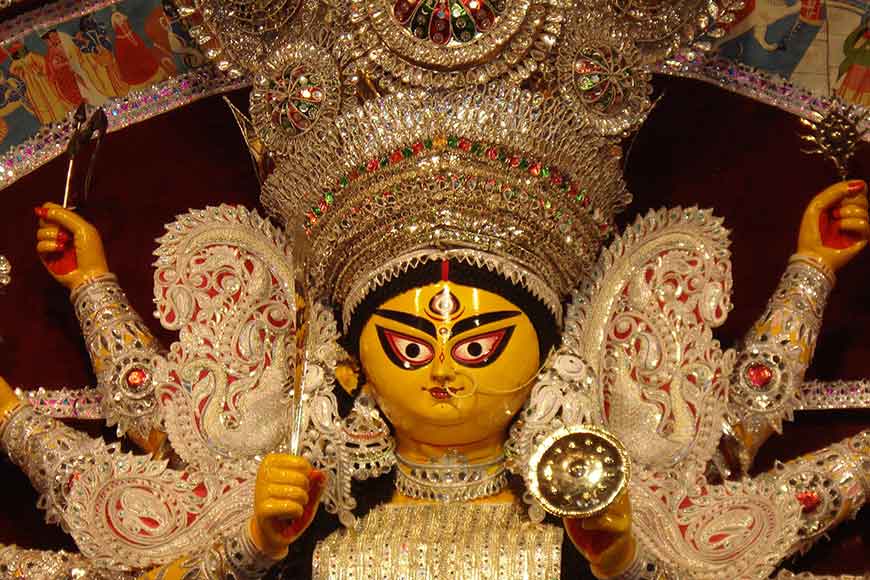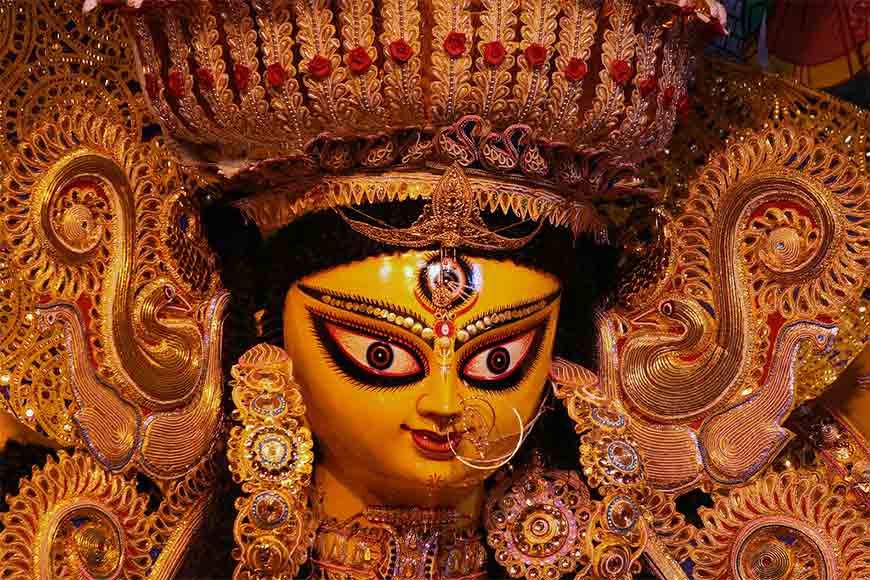Durga’s ornaments came from Germany by post! Daaker Saaj redefined!

‘My ornaments are fruits, my garments leaves, woven like cloth of gold and crimson dyed---’ may be the autumn Goddess bespoke of her own saaj, ornaments that happen to be every woman’s pride. Devi Durga in all her splendour, makes a grand entry, decked like the enchanting priestess of Olympus. Ornamentation or saaj of those clay idols made by artisans, is as important as the basic idol itself, for saaj reflects her grandeur and superior elegance.
Devi Durga’s ornamentation has evolved over the ages. In Bengal, the handicraft industry that has developed around the intricacies and nuances of her Saaj need detailed analysis and documentation to understand how she got her final touches of splendour. Durga’s Saaj reflects various folk-art forms of Bengal, such as Kantha work, (embroidery on quilt practiced by Bengal’s womenfolk), Brata Alpona (motifs and designs done during rituals), textile weavings and so forth.
Variation in Saaj, changed down centuries, depending on varieties of raw materials and ingredients found in commercial markets. Even contemporary fashion has influenced Saaj along with economic and social factors. Thus, a genre of Saaj Shilpa came into existence. An overview of this ornamentation, provides a scope to study the chronological history of jewellery of Bengal. During a certain era, fashion trends were dictated by Bengal’s royalty. The mythological inference provides a range of ornaments, that were bestowed upon Devi Durga by Gods as she moved to fight the fierce battle with Mahisasura.
 According to Markendeya Purana, Devi Durga was decked up with natural elements. The Ocean gave her a pearl necklace, new saree, Kundal or earring, Bala or bracelet and Bajubandha or armlet, Kantha Bhusana or different kinds of necklaces, Tikli (or tiara), Nupur or anklets and finger rings. Ocean also decked her head with a lotus garland, a necklace with seven tiers or Satnari Haar and a blooming lotus. While, Nagraj gave her a Naag Haar and Kuber gave her a Paan Patra (drinking pot).
According to Markendeya Purana, Devi Durga was decked up with natural elements. The Ocean gave her a pearl necklace, new saree, Kundal or earring, Bala or bracelet and Bajubandha or armlet, Kantha Bhusana or different kinds of necklaces, Tikli (or tiara), Nupur or anklets and finger rings. Ocean also decked her head with a lotus garland, a necklace with seven tiers or Satnari Haar and a blooming lotus. While, Nagraj gave her a Naag Haar and Kuber gave her a Paan Patra (drinking pot).
Since onset of civilisation, humans had a wish to beautify themselves with ornaments made from natural products, like leaves, twigs, seeds, pebbles, stones, bones of animals or fired clay. Later, they used metals to ornate their body. The very first example of ornaments on figures were unearthed from ruins of Indus Valley civilization, which was succeeded by chronological trends established by later dynasties.
Ornaments like Har, Hemsutra, Rasona, Angad, Kundal, Balaya, Keyur etc were mentioned in the epic Ramayana and in ancient literary works like Sudraka’s Mrichhakatikam (2nd century BC), Dasakumar Charitra (7th century), Banabhatta’s Kadambari and Harshacharitra, Barahamihir’s Brihad Samhita (6th century) and Shishupala Vadha by Magha (7th century).
A plethora of ornaments worn by Gods and Goddesses have found place in the mythological texts and ancient literary works. The implications of wearing various kinds of ornaments were also specified. Few distinct types of ornaments are noticeable in numerous sculptures, like Ratnajali, a head ornament with encrusted jewels that covers the head, Kirit Kundala, a kind of crest or mukut that Devi Durga adorns as a head-dress, Hemsutra or necklace, Balaya or Bala, a kind of bangle and finger rings, Hem Mekhla, ornamental girdle and Kinkini, a girdle or an anklet set with small jingling bells.

With the rise and fall of ruling dynasties, ornament-makers of Bengal have not only followed trends set by royal families, but incorporated indigenous and local motifs and designs as a continuous undercurrent of artistic expression. When Durga puja was initiated in Bengal, the idol was decked with ornaments that were a kind of exaggeration, to imbue a sense of super naturalism within the deity. This is specifically reflected in ornaments like Makar Beni, Ghar Beni, ornamentation on sides of ears, huge dangling ear rings etc. Gradually, Devi’s Saaj turned more contemporary. Continuous incorporation of local and indigenous motifs gave a unique look to the whole ornamentation. For example, motifs inspired by local flora and fauna, have been simultaneously used in the intricate embroidery designs of Kantha work, the warp and weft of a saree, found place on Durga’s ornaments. Embellishments of decorative designs and patterns, reflected tastes of patrons and imbibed folk expressions of definite locales, proving the birth of an eclectic vision.
In the ancient and middle ages, Bengal came under the influence of North Indian urban artistic tastes, preferred by the elite class. Bengal being an important trade hub, served as a confluence of various cultural paradigms, where foreign and indigenous rulers along with feudal lords, mercantile class and prostitutes, played a vital role in giving form to the prevailing ornament designs. Jewelry names also came from literary works such as Manasa Mangal, Kalika Mangal, Krittibas’ Ramayana, Kashiram Das’ Mahabharata, Shankar Das’ Bhagavata Gita.
Raja Krishnachandra of Krishnanagar gave Durga puja a huge impetus socially and culturally, going beyond the threshold of its strict religious attribute. The Durga idol that was worshipped in Krishnanagar Rajbari or royal household was draped and decorated with very different kind of attire that was quite uncommon in the then Bengal.
Saaj can be ornaments of clay, those made from Sholapith (a water weed) called Sholar Saaj and Daaker Saaj, made with metallic wires, sheets and foils imported from other countries. The archetypal Durga idols made by ancient potters of Bengal were embellished with ornaments, inspired by these preceding classical Indian sculptures. Clay ornaments were unique in their simplicity of design and make. They were mostly made by assembling clay pellets of various sizes and were based upon simple geometric patterns. Later, ornament makers incorporated patterns of flora, fauna and decorative motifs, which made designs more intricate and subtle. Generally, clay ornaments include Mukut and necklaces.
During 17th century, local administrators, hailed as kings, started worshipping Durga within their household. Raja Kamsanarayan of Taherpur was the first to start Durga Puja in Bengal. Later, Raja Krishna Chandra Roy of Krishnanagar, patronized Durga puja, establishing the celebration not as a mere religious festival, but as an occasion to flaunt wealth and power before the Nawabs, who were then ruling Bengal. Raja Naba Krishna Deb, set the trend of Durga Puja in 18th century British Calcutta, that became a status symbol and gained importance, essentially reflecting the ‘babu’ culture. It was during this phase that exports and imports of raw materials and finished products between India and Britain was also gaining ground.
 Daaker Saaj was derived from the word Daak (post), as the raw materials required for making these ornaments, were imported from Germany and arrived in Bengal by post. Another probable reason might be that raw materials used, were manufactured by ‘Duck’ company. A kind of thread is wrapped with a glittery wire, popularly known as ‘rolex.’ These threads were wrapped with gold, silver and copper wire or were reels of metallic wires, known as Salma and Bulen, which were later substituted by ‘rolex.’ Daaker Saaj was made extremely popular in Bengal for its highly intricate and detailed execution. There were Sholar Saaj, Daaker Saaj, Tabaker Saaj and Bulener Saaj.
Daaker Saaj was derived from the word Daak (post), as the raw materials required for making these ornaments, were imported from Germany and arrived in Bengal by post. Another probable reason might be that raw materials used, were manufactured by ‘Duck’ company. A kind of thread is wrapped with a glittery wire, popularly known as ‘rolex.’ These threads were wrapped with gold, silver and copper wire or were reels of metallic wires, known as Salma and Bulen, which were later substituted by ‘rolex.’ Daaker Saaj was made extremely popular in Bengal for its highly intricate and detailed execution. There were Sholar Saaj, Daaker Saaj, Tabaker Saaj and Bulener Saaj.
Devi’s Mukut, is usually known as Jhaka, which at times consist of five kalkas (a decorative motif derived from local flora fauna, used in textiles) or two kalkas creating a shape of a beetle nut leaf. Her ears have two extended decorative patterns stretching sideways, known as Makar Beni and Ghar Beni, while the earring is called Kaan Bala. While making the Aanchal (extended drape of idol), artisans maintain exact folds, identical to that of an original Aanchal worn by a Bengali woman. The intricate designs reflect artistic ingenuity and precision. As per ‘Hutom Pyanchar Naksha’ written by Kaliprasanna Singha, Saaj artists used to come from Krishnanagar.
Sholar saaj (wood sponge ornamentation) brought a much-needed variation and paved a way for opportunity for Solapith artists. To reduce monotony of white wood sponge, Dak ornamentation (Daker Saaj) emerged, that helped in playing of light and shade (chiaroscuro).










